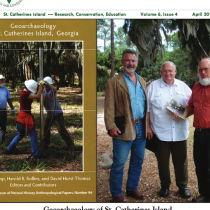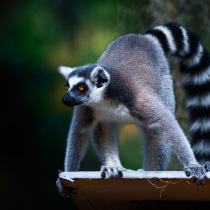The Rauers family sold St. Catherines Island to three investors (Keys, Coffin, and Wilson) from Detroit in 1929. Howard Coffin is well known for his involvement with St. Simons Island, Sea Island, and his restoration of a mansion on Sapelo Island that is today called “The Reynolds’ Mansion.” Between 1929 and 1931, the three restored one of the tabby slave cabins known today as Button Cabin. They also built a powerhouse for generating electricity, which is used today for a classroom, lab, and the island director’s office. Six additional guest cabins were constructed along an avenue near Button Cabin (called the Shell Road). All seven guest cabins are still in use today by visiting scientists and students. The threesome demolished the Rauers family’s mansion, built three staff houses (one is still standing today), added extensively to the Button Gwinnett house, and built a house for the superintendent. The Great Depression had a negative impact on the fortunes of the three, and Wilson never occupied the house that was built for him. Howard Coffin died, Wilson left, and the Keys attempted to continue solo with their plans for SCI. In 1937, St. Catherines Island reverted back to the Rauers family. In an attempt to offset expenses, the Rauers family cut and sold timber. The Rauers family had cut most of the old-growth pine by the time they sold St. Catherines Island to Edward J. Noble of New York in 1943. At that time, there was a horse-mounted National Guard and Coast Guard unit housed in a barracks on the island’s South Beach. The men were also housed in a couple of the north end cabins. The Coast Guard’s mission was to patrol for U-Boats.
After the end of World War II, Noble had one of the cut-over forests cleared—stumps were removed, land was leveled, bahiagrass was planted, and black Angus cattle were introduced. Noble owned the Life Savers candy company and, during the 1950s, he hosted corporate meetings of that company on the island. He also hosted such guests as former President Dwight D. Eisenhower and former President Richard Nixon.
Around 1930, the Keys family hired John Toby Woods to supervise their activities on the island. Mr. Toby, as staff called him, worked for the Keys family, the Rauers family, Noble, and for the E.J. Noble estate. His son, John Toby Woods, Jr., became the island’s superintendent for the E.J. Noble estate in 1962, for the E.J. Noble Foundation from 1969 to 1981, and for the St. Catherine’s Island Foundation from 1981 to 1982.
In the late 1960s, June Noble Larkin, Frank Y. Larkin, and Al Chapman began to research different options for how the island could be best put to use while still retaining its special wildness. A consultant was hired to write a conservation plan, and they sought the advice of scientists and conservationists from the American Museum of Natural History, the New York Zoological Society (NYZS), and the University of Georgia. Dr. Eugene Odum was one of the scientists from the University of Georgia sought out by the Larkins.
The American Museum of Natural History (AMNH) was asked to supervise a research program on the island and the NYZS agreed to run a “survival center” for the breeding of endangered wildlife species. In 1972, the first researchers from the AMNH came to SCI in order to conduct surveys of flora and fauna on the island. In 1974, the NYZS brought the first endangered animals to SCI, and Dr. David Hurst Thomas of the AMNH arrived to see if the island had any potential for archaeological research. Though the survival center closed in 2004, Thomas continues to direct archaeological research on the island.
The title of the island was transferred to the St. Catherines Island Foundation in 1981. The Noble Foundation is still the main source of funding for the research, education, and conservation programs being conducted on the island.
Wildlife Survival Center Facility Resources
From 1974 to 2007, the Wildlife Conservation Society operated a breeding facility on St. Catherines Island for rare and endangered species. As a result of this ambitious project, several thousand mammals, birds, and reptiles of 54 different species lived in the island’s facilities over its 33-year existence. The breeding facilities are located in the southern section of the main Compound, although few are in use today.
Animals bred at the center included:
- 355 reptiles of three species
- 545 birds of 29 species
- 808 mammals of 22 species
Related Publications
Geoarchaeology of St. Catherines Island, Georgia
The field of geoarchaeology has typically been defined as either geology pursued within an archaeological framework or sometime the reverse, as archaeology framed with the help of geological methodology. Either way, the formalized objectives of geoarchaeology define a broad range of pursuits, from placing archaeological sites into relative and absolute temporal context through the application of stratigraphic principles and absolute dating techniques, to understanding the natural processes of site formation, to reconstructing the landscapes that existed around a site or group of sites at the time of occupation.
- Date Published : April 2011
- Read more
25th Annual Christmas Bird Count, December 17th, 2011
On Friday, December 16th, 42 birders hopped on boats at the mainland eager to get to St. Catherines and check out their assigned areas in preparation for Saturday, the 25th Christmas Bird Count (CBC) on SCI. This is part of The National Audubon Society’s 112th CBC, with the count taking place in over 2,000 locations from December 14th—January 5th.
This year was our third best count with 140 species and 33,383 individuals on count day. Four additional species were seen during count week, and the total of 144 matched (with 2002) the highest number during count-week.
- Date Published : January 2012
- Read more
After 30 Years of Animal Research, Bronx Zoo to Close Island Preserve
The Bronx Zoo has closed a large animal preserve on a 14,000-acre undeveloped island off the coast of Georgia, where for 30 years zoologists have studied – among other things – the mating habits of wildlife, including lemurs, hartebeests, zebras, tortoises, gazelles and several species of exotic birds.
- Source : The New York Times
- Date Published : December 29, 2004
- Read more
Lemurs, hartebeests, hornbills call island home
In the interior of St. Catherines Island, deer roam freely and wild hogs jog playfully throughout the woods. Suddenly, in the distance, a sound not native to the area is heard. A group of ring-tailed lemurs hangs from the trees, a small herd of African Jackson hartebeests prances by, and an exotic great hornbill bird is spotted. Welcome to the sanctuary of St. Catherines Island Wildlife Survival Center.
- Source : The Coastal Courier
- Date Published : June 8, 2009
- Read more
The Saint behind St. Catherines Island
Do you ever wonder where St. Catherines Island got its name? Recent research on artifacts recovered at Mission Santa Catalina de Guale, located on St. Catherines Island, has provided some insight into this very question. Ironically, the information regarding the name source comes to us from an object recovered on Amelia Island (Florida). There are actually four Santa Catalina de Guale missions in Spanish Florida. The earliest (Santa Catalina de Guale I), built on St. Catherines Island, was attacked in 1680 by British troops and Indian allies, probably in a slave raid. After the attack, the residents relocated to nearby Sapelo Island, establishing the second location of Mission Santa Catalina (II, 1680–1683).
- Date Published : April 2012
- Read more
Recent History of the North Pasture
Most of the Gopher Tortoises on St. Catherines Island live in North Pasture. Some have formed colonies on other parts of SCI only to return to North Pasture after a few years. Some people call North Pasture (NP) the “North Savanna”. Some have described it as a Long-leaf Pine Flat-wood and another as a managed Long-leaf Pine forest. It was Georgia’s largest stand of mature LL pine on a barrier island when the logging began (1938). Mr. Noble purchased the island in 1943. At that time loggers held timber contracts for most of the remaining timber on SCI.
- Date Published : April 2013
- Read more
Throughfall and Stemflow in the Forest Canopy
Forests provide many known ecosystem services— they clean our air, sequester our carbon emissions, protect our soils from erosion, provide habitat for species on which we rely for sport and ecotourism, and much more. While the list goes on, there are likely even more ecosystem services which have yet to be discovered. What other amazing services do forests provide to our ecosystem? That’s the question at the heart of Dr. John Van Stan’s (Fig. 1) research on St. Catherines Island. To begin answering this question, Dr. Van Stan is currently installing monitoring equipment that will allow him and his colleagues at Georgia Southern University, Skidaway Institute of Oceanography, and the Helmholtz Centre for Environmental Research (in Leipzig, Germany) to track water and nutrients as they move from the canopy into the soils and freshwater lens and, ultimately, out to the ocean. They expect to find new forest influences over each of these ecosystem components critical to barrier islands as a whole.
- Date Published : August 2012
- Read more
Survey of St. Catherines Island’s Aquatic Beetles
Students of the department of Biological and Environmental Sciences at Georgia College reveled in the opportunity to explore St. Catherines Island and its aquatic fauna with me. These students (from five countries) are currently participating in classes, including Entomology, Aquatic Entomology, and Invertebrate Zoology as well as independent research. Most of the students come fully trained with collecting and curating techniques of invertebrates and particularly beetles, and are already quite adept for our task of collecting and analyzing beetles of SCI.
- Date Published : December 2012
- Read more
Southeastern American Kestrels
In January 2012, St. Catherines Island hosted the 1st Southeastern American Kestrel Working Group meeting, led by Ken Meyer of Avian Conservation and Research Institute (ACRI). This meeting was a culmination of a planning project being facilitated by ACRI with a National Fish and Wildlife Foundation grant to understand the status of and concerns for the SE American Kestrel. Florida, Mississippi, Alabama, and Georgia state and federal personnel attended to report the status of the birds in their area, and to identify needs that each state has to learn more about the status of these Kestrels and understanding their limiting resources. Coming together as a cooperative working group gives biologists and land managers a better understanding of large-scale needs and resources of this species and their habitats.
- Date Published : February 2012
- Read more

